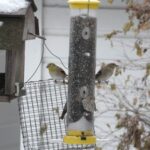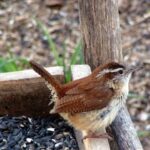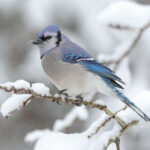The first time I saw a Carolina wren (Thryothorus ludovicianus) in my yard, it was hopping around my husband’s riding lawnmower. I thought at first that I was watching a chipmunk, which is why I have nicknamed Carolina wrens “chipmunk wrens.”
These perky little birds do have chipmunk-like qualities. Carolina wrens have reddish-brown upper-parts – very similar to chipmunks – with white stripes above their eyes and down their throats. The under-parts of their bodies are a buff color. The tails of the Carolina wrens stick straight up in the air, contributing even more to their chipmunk look. They are the largest of all the wrens (5½ inches) in their territory, which includes the entire southeastern part of the United States. Carolina wrens do not migrate, and their population can suffer during particularly cold winters. They can be found in woodland lots, thickets, brush piles, and swamps. (I have established a brush pile in the back of my property, and the Carolina wrens – as well as various other birds and animals, such as wild rabbits – just love it. A note to my fellow gardeners: If you do not want your brush pile to look too unsightly, train honeysuckle to grow over it. You can also plant bushes in front of it, such as forsythia, to camouflage your brush pile.) Fred J. Alsop III notes about the nesting habits of Carolina wrens: “They build nests in almost any available cavity, including old woodpecker holes and holes in fence posts, stonewalls, tree stumps, and buildings as well as nesting boxes, pails, pockets of hanging cloths [sic], mailboxes, open cans, open bags, and hanging baskets.”1 They lay 3-8 spotted white to pinkish-colored eggs twice during their breeding season. The female Carolina wren will incubate the eggs for about 14 days, and the fledglings leave the nest in 13-14 days.
Carolina wrens like all types of insects, including beetles, stinkbugs, leafhoppers, sow bugs, and snails. They also like small lizards. You can attract these wrens to your yard by hanging suet feeders. Remember to supply them with a source for water. Also, planting shrubs and providing with them other dense forms of vegetation, as well as a brush pile (see above) will help lure them to your yard. (One note of interest: throglodytidae, which is the scientific name for the wren family, is Latin for “cave dweller” and refers to wrens’ propensity for preferring dark places.2)
Carolina wrens are delightful little birds to watch hopping about your yard. I have even seen them from my kitchen window flitting around on my deck. So, if you see something that looks and flits about on the ground like a chipmunk, and it starts flying – well, you are not looking at a flying chipmunk. You have just seen a Carolina wren.
1Alsop III, Fred J. All About Tennessee Birds. Birmingham, AL: Sweetwater Press, 1997, pp. 135.
2Ibid, p. 134.
Sources:
Alsop III, Fred J. All About Tennessee Birds. Birmingham, AL: Sweetwater Press, 1997, pp. 134-5.
Bull, John and Farrand, Jr., John. National Audubon Society Field Guide to North American Birds: Eastern Edition. NY: Alfred A. Knopf, 1994, pp. 622-3.




